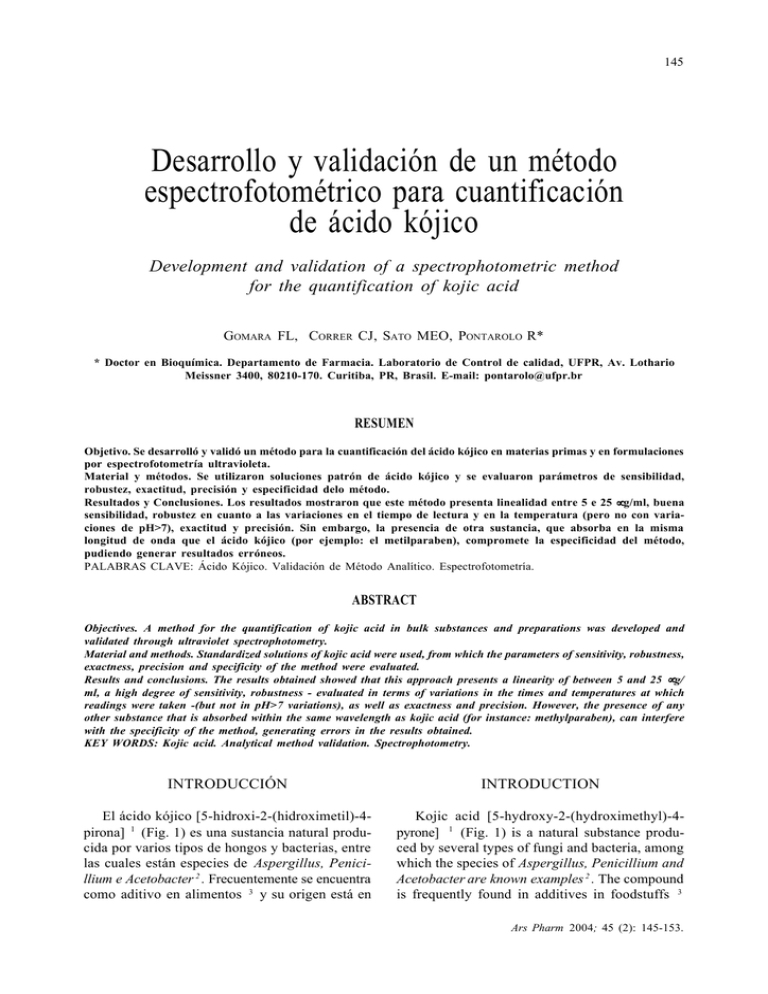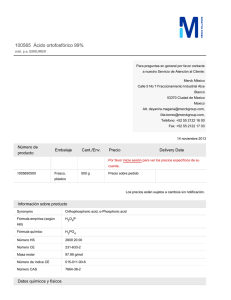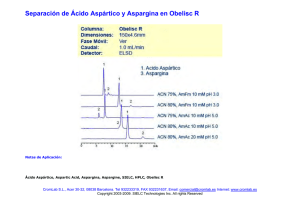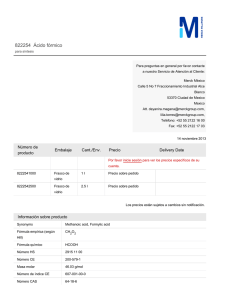Desarrollo y validación de un método espectrofotométrico para
Anuncio

DESARROLLO Y VALIDACIÓN DE UN MÉTODO ESPECTROFOTOMÉTRICO PARA CUANTIFICACIÓN DE ÁCIDO KÓJICO 145 Desarrollo y validación de un método espectrofotométrico para cuantificación de ácido kójico Development and validation of a spectrophotometric method for the quantification of kojic acid GOMARA FL, CORRER CJ, SATO MEO, PONTAROLO R* * Doctor en Bioquímica. Departamento de Farmacia. Laboratorio de Control de calidad, UFPR, Av. Lothario Meissner 3400, 80210-170. Curitiba, PR, Brasil. E-mail: [email protected] RESUMEN Objetivo. Se desarrolló y validó un método para la cuantificación del ácido kójico en materias primas y en formulaciones por espectrofotometría ultravioleta. Material y métodos. Se utilizaron soluciones patrón de ácido kójico y se evaluaron parámetros de sensibilidad, robustez, exactitud, precisión y especificidad delo método. Resultados y Conclusiones. Los resultados mostraron que este método presenta linealidad entre 5 e 25 µ g/ml, buena sensibilidad, robustez en cuanto a las variaciones en el tiempo de lectura y en la temperatura (pero no con variaciones de pH>7), exactitud y precisión. Sin embargo, la presencia de otra sustancia, que absorba en la misma longitud de onda que el ácido kójico (por ejemplo: el metilparaben), compromete la especificidad del método, pudiendo generar resultados erróneos. PALABRAS CLAVE: Ácido Kójico. Validación de Método Analítico. Espectrofotometría. ABSTRACT Objectives. A method for the quantification of kojic acid in bulk substances and preparations was developed and validated through ultraviolet spectrophotometry. Material and methods. Standardized solutions of kojic acid were used, from which the parameters of sensitivity, robustness, exactness, precision and specificity of the method were evaluated. Results and conclusions. The results obtained showed that this approach presents a linearity of between 5 and 25 µ g/ ml, a high degree of sensitivity, robustness - evaluated in terms of variations in the times and temperatures at which readings were taken -(but not in pH>7 variations), as well as exactness and precision. However, the presence of any other substance that is absorbed within the same wavelength as kojic acid (for instance: methylparaben), can interfere with the specificity of the method, generating errors in the results obtained. KEY WORDS: Kojic acid. Analytical method validation. Spectrophotometry. INTRODUCCIÓN INTRODUCTION El ácido kójico [5-hidroxi-2-(hidroximetil)-4pirona] 1 (Fig. 1) es una sustancia natural producida por varios tipos de hongos y bacterias, entre las cuales están especies de Aspergillus, Penicillium e Acetobacter 2 . Frecuentemente se encuentra como aditivo en alimentos 3 y su origen está en Kojic acid [5-hydroxy-2-(hydroximethyl)-4pyrone] 1 (Fig. 1) is a natural substance produced by several types of fungi and bacteria, among which the species of Aspergillus, Penicillium and Acetobacter are known examples 2 . The compound is frequently found in additives in foodstuffs 3 Ars Pharm 2004; 45 (2): 145-153. 146 GOMARA FL, CORRER CJ, SATO MEO, PONTAROLO R. la fermentación del arroz, en condiciones aeróbicas y alto contenido como fuente de carbono4 . Entre sus propiedades se incluyen la acción antimicrobiana y quelante de iones cobre. Esta última, se apunta como la responsable de su acción inhibitoria de la tirosinasa, que interfiere en la cascada melanogénica reduciendo la producción de eumelanina, de acción pigmentante 5 ,6 . Ese mecanismo confiere al ácido kójico acción aclaradora, permitiendo su uso en preparaciones dermofarmacéuticas utilizadas en el tratamiento tópico de las discromías7 ,8 (modificaciones en la coloración normal de la piel por diferencias cuantitativas de pigmentos)9 . originating from the fermentation of rice under aerobic conditions and from sources high in carbon content4 . Among the properties attributed to the compound are its antimicrobial activity, as well as its chelating action on copper ions. This last activity is believed to be responsible for the inhibitory action of tyrosinase, which interferes with the melanogenic cascade by reducing the production of eumelanin in pigmentation activity5 ,6 . Such a mechanism confers kojic acid with a whitening action, which allows this product to be used in dermopharmaceutical preparations for topical treatments of dyschromia7 ,8 (modifications in normal skin colouring, due to quantitative pigment differences)9 . FIGURA 1. Estructura del ácido kójico FIGURE 1. Structure of kojic acid O CH HO O La validación analítica es uno de los elementos básicos en sistemas de calidad. El hecho de validar trata de disminuir o controlar los factores que llevan a la imprecisión o inexactitud de un dato generado, a través de la realización de un trabajo analítico dentro de unos parámetros definidos. La validación de un método analítico provoca una mayor fiabilidad y aceptación de los datos generados, estando estas en proporción con la calidad del proceso de obtención de los mismos 10 . Teniendo en cuenta el amplio uso do ácido kójico en formulaciones aclaradoras dermatológicas2, tanto de forma aislada como en asociación 8,11 , y el facto de no disponer de un método de referencia del ácido kójico descrito en farmacopeas se hace necesario disponer de métodos validados confiables de cuantificación de esa sustancia. La cuantificación del ácido kójico por espectrofotometría ultravioleta es posible debido a la presencia de dobles enlaces alternados y pares de electrones no covalentes en su estructura (Fig. 1). Este trabajo tiene como objetivo el desarrollo y validación de un método analítico para la cuantificación del ácido kójico por espectrofotometría ultravioleta. Ars Pharm 2004; 45 (2): 145-153. Analytical validation is one of the basic elements in quality systems. The carrying out of validation processes represents an attempt to decrease or control the factors that lead to imprecision or in-exactness in the data obtained, through analyses performed within defined parameters. The validation of an analytical method affords a greater degree of reliability to the data obtained. The resulting findings are directly proportional to the quality of the processes designed to obtain such data. Given that kojic acid is widely used in dermatological whitening formulations1, both independently and in conjunction with other products1,10 , the fact that no reference method for kojic acid is available in pharmacopoeias, suggests that reliable quantification methods for this substance are required. The quantification of kojic acid through ultraviolet spectrophotometry is possible, due to the presence of double alternating links and pairs of non-covalent electrons in its structure (Fig. 1). The aim of this work was to develop and validate an analytical method for the quantification of kojic acid, through ultraviolet spectrophotometry. DEVELOPMENT AND VALIDATION OF A SPECTROPHOTOMETRIC METHOD FOR THE QUANTIFICATION OF KOJIC ACID MATERIAL Y MÉTODOS 147 MATERIALS AND METHODS Medidas espectrofotométricas Spectrophotometric measurements La absorbancia de soluciones acuosas conteniendo ácido kójico (Sigma Aldrich Chem.Co.) 25 ug/ml fue determinada en espectrofotómetro Shimadzu UV-1601PC, entre 200 a 400 nm, en intervalos de 1nm, con agua como referencia. The absorbance of aqueous solutions that contain kojic acid (Sigma Aldrich Chem.Co.) 25ug/ ml were determined using a Shimadzu UV-1601PC spectrophotometer, between 200 and 400nm, at intervals of 1nm, with plain water as reference. Linealidad e intervalo Linearity and interval Fueron preparadas en triplicada soluciones conteniendo 5, 10, 15, 20 e 25 ug/ml de ácido kójico. La absorbancia fuera determinada en triplicada en la longitud de onda de 269nm, totalizando nueve lecturas para cada muestra. La curva de calibración conseguida a partir de estas medidas fue analizada por método de regresión linear, calculando-se el coeficiente de correlación e la ecuación de la reta. Solutions containing 5, 10, 15, 20 & 25ug/ml of kojic acid were prepared in triplicate. Absorbance was determined in triplicate at a wavelength of 269nm with a total of nine readings for each sample. The calibration curve obtained from these measurements was analysed through linear regression method, in which the correlation coefficient and equation of a straight line were calculated. Valuación de robustez Evaluation of robustness La robustez del método se evaluó considerando la influencia del pH, del tempo de lectura y de la temperatura. Para la evaluación de la influencia del pH se prepararon soluciones de ácido kójico 20 µg/ml con soluciones tampón de diferentes valores de pH (1-10). La lectura de las absorbancias se realizó a λ=269 nm, 20°C, inmediatamente después de la preparación de las muestras (n =6). La influencia del tiempo de lectura se evaluó preparando soluciones acuosas de ácido kójico 20 µg/ml, con lectura de las absorbancias (λ= 269 nm, 20°C) realizándose en los tiempos de 0 a 8 horas después de la preparación de las muestras (n =6). Finalmente, la influencia de la temperatura se determinó realizando la lectura de las absorbancias (λ=269nm) de nuevas soluciones de ácido kójico 20 µg/ml, inmediatamente después de la preparación de las muestras, a temperaturas de 5°C, 20°C e 35°C (n =6). The robustness of the method was evaluated by assessing the influence of pH, reading time and temperature. In the assessment of the influence of pH, kojic acid solutions of 20µg/ml were prepared with buffer solutions of differing pH values (1-10). The absorbance readings were carried out at λ=269nm, 20°C, immediately after the preparation of the samples (n=6). The influence exerted by the time factor was evaluated through the preparation of aqueous solutions of kojic acid 20µg/ml, from which absorbance readings (λ= 269 nm, 20°C) were taken at varying time intervals from 0 to 8 hours after the preparation of the samples (n=6). Finally, the influence of temperature was determined by performing absorbance readings (λ=269nm) on fresh solutions of kojic acid 20 µg/ml, immediately after the preparation of the samples, at temperatures of 5°C, 20°C & 35°C (n =6). Determinación de exactitud Determination of exactness La exactitud se verificó por medio de la prueba de la recuperación 12 . Se incorporaron cantidades conocidas de ácido kójico patrón a un Exactness is verified by means of the recovery test11 . Determined quantities of standard kojic acid were added to a vehicle (non-ionic O/A Ars Pharm 2004; 45 (2): 145-153. 148 GOMARA FL, CORRER CJ, SATO MEO, PONTAROLO R. vehículo (emulsión O/A no iónica sin conservante metilparaben; n=3) obteniéndose muestras conteniendo 0,5%, 1% e 2% de principio activo. Cantidades apropiadas de las muestras se diluyeron con agua hasta un volumen final de 100 ml y las soluciones resultantes se filtraron en papel de filtro cualitativo. Las soluciones filtradas se diluyeron, con el fin de obtenerse soluciones con concentración de 20 µg/ml de ácido kójico, el contenido se determinó a partir de la ecuación de la recta y se calculó el porcentaje de recuperación del método. Se utilizó agua como referencia y solución de ácido kójico patrón 20µg/ml como control. emulsion without methylparaben preservative; n=3), from which samples containing 0.5%, 1% & 2% of active principle were obtained. Appropriate quantities of the samples were diluted with water to a final volume of 100ml and the resulting solutions were filtered on qualitative filter paper. The filtered solutions were diluted, as a means to obtaining solutions with a concentration of 20 µg/ml of kojic acid. The content was determined from the equation of a straight line and the recovery percentage of the method was calculated. Water was used as reference and standard kojic acid solution 20µg/ml as control. Determination of precision Determinación de precisión La precisión fue verificada evaluándose las condiciones de repetibilidad y precisión intermediaria. Se prepararon soluciones de ácido kójico patrón a las concentraciones de 5, 10, 15, 20 e 25 µg/ml y las absorbancias de las soluciones leídas en un mismo día (n=3) y en dos días diferentes (n=6). Se calculó la desviación estándar relativa (DER) con los resultados obtenidos. Precision was verified by evaluating replicability and intermediate precision. Standard kojic acid solutions were prepared at concentrations of 5, 10, 15, 20 & 25µg/ml and the absorbance readings were taken on the same day (n=3) and additionally, on two different days (n=6). The relative standard deviation of the results obtained was calculated. RESULTS AND DISCUSSION RESULTADOS Y DISCUSIÓN El método de determinación del ácido kójico por espectrofotometría ultravioleta se realizó en la longitud de onda en que ocurre la absorción máxima del fármaco. El espectro de absorción del ácido kójico muestra un máximo de absorción en la longitud de onda de 269 nm (Fig. 2). The method of determination of kojic acid through ultraviolet spectrophotometry was carried out at a wavelength at which the maximum absorption of the drug takes place. The absorption spectrum of kojic acid shows maximum absorption at a wavelength of 269nm (Fig. 2). FIGURA 2. Espectro del ácido kójico 25µg/ml en agua. FIGURE 2. Kojic acid spectrum 25µg/ml in water. Ars Pharm 2004; 45 (2): 145-153. DESARROLLO Y VALIDACIÓN DE UN MÉTODO ESPECTROFOTOMÉTRICO PARA CUANTIFICACIÓN DE ÁCIDO KÓJICO 149 Linealidad Linearity La curva de calibración (Fig. 3) se obtuvo por la absorbancia de diferentes concentraciones de ácido kójico y muestra que en el intervalo de 5 a 25 µg/ml el método es lineal y presenta un coeficiente de correlación (r) igual a 0,9994. La linealidad determina la región de la curva respuesta o de cuantificación en que hay relación directa entre la señal instrumental y la concentración del producto analizado14, siendo un método lineal 13 cuando presenta una r > 0,99. La pendiente de la recta de la curva patrón fue de 0,0644, indicando también buena sensibilidad. La sensibilidad es entendida como a capacidad del método de distinguir, con determinado nivel de confianza, dos concentraciones próximas 13,14 The calibration curve (Fig. 3) was obtained through the absorbance readings of different concentrations of kojic acid and showed that, within the interval of 5 to 25µg/ml, the method is lineal and presents a correlation coefficient (r) of 0.9994. Linearity determines the region of the response or quantification curve, in which a direct relationship between the signal given by the instrument and the concentration of the product analysed exists13 . The method may be considered as being lineal when r values of r > 0.99 are obtained. 12 . The slope of the straight line of the standard curve was 0.0644, which also indicated a high degree of sensitivity. Sensitivity is understood as meaning the capacity of the method to distinguish, with a determined degree of reliability, two proximal concentrations12,13. FIGURA 3. Curva de calibración del AK (n=9) FIGURE 3. Calibration curve of KA (n=9) 1,6 1,44 1,28 1,12 0,96 A 0,8 0,64 0,48 0,32 0,16 0 Y = 0,06244 X R = 0,9994 0 5 10 15 20 25 30 C Leyenda: C=Concentración µg/ml; A= Absorbancia. Legend: C = Concentration µg/ml; A = Absorbency; Robustez Robustness Al evaluarse la robustez del método, esto es, la capacidad del resultado de no sufrir alteraciones por pequeñas modificaciones en los parámetros de análisis 13, se comprobó que los retrasos en el tiempo de lectura (de 1 a 8 horas) y las variaciones de temperatura (de 5°C a 35°C) no interfieren en los resultados obtenidos, manteniéndose constantes los valores absorbancia en 269nm. Cambios en los valores de pH del medio, sin embargo, pueden interferir en el análisis cuantitativo del ácido kójico. Esa influencia del valor del pH del medio en la cuantificación del ácido kójico se muestra en la Fig. 4, en que se observan alteraciones en la absorbancia a pH>7. A este pH, posiblemente se produzca la ionización del hidroxilo enólico del fármaco, alterando On evaluating of the robustness of the method, that is to say, its capacity for not being subject to alterations caused by slight modifications in analysis parameters 12, delays in reading times (from 1 to 8 hours) and variations in temperature (from 5 to 35°C) were carried out, in order to determine whether such variations interfered with the results obtained. The absorbance values were kept at a constant of 269nm. However, changes in average pH values may interfere with the qualitative analysis of kojic acid. Such an influence on the quantification of kojic acid is shown in Fig. 4, in which alterations in absorbance at pH>7 can be observed. At this pH value, a process of ionisation of the enolic hydroxyl of the drug possibly takes place. Such a process Ars Pharm 2004; 45 (2): 145-153. 150 GOMARA FL, CORRER CJ, SATO MEO, PONTAROLO R. su estructura electrónica y consecuentemente su absorción en el ultravioleta 14 . would alter its electronic structure and consequently, its ultraviolet absorption 13 . FIGURA 4. Influencia del pH en la absorbancia. FIGURE 4. Influence of pH on absorbency 0,9 0,8 0,7 0,6 A 0,5 0,4 0,3 0,2 0,1 0 1 2 3 4 5 6 7 8 9 10 pH Leyenda: pH= pH de la solución; A= Absorbancia; n=6. Legend: pH = pH of the solution; A = Absorbance; n =-6. Exactitud Exactness Los valores referentes a la exactitud del método, obtenidos por medio de la prueba de recuperación, se encuentran en la tab. 1. El porcentaje de ácido kójico recuperado muestra que el método presenta exactitud, o sea, que los valores obtenidos en la determinación están próximos do valor verdadero. Porcentajes de recuperación entre 98% e 102% son considerados aceptables13. With regard to the exactness of the method, the values obtained through the recovery test are found in Table 1. The percentage of recovered kojic acid shows that the method can be considered as being exact. This is to say that the values obtained in its determination are close to true values. Recovery percentage values from between 98% and 102% are considered as being acceptable12 . TABLA 1. Exactitud del método por ensayo de recuperación. TABLE 1. Exactness of the method measured through the recovery test. Muestras Muestra Incorporada 0,5% de patrón Samples Sample with 0.5% of incorporated standard Absorbancias Absorbancies Abs. Media Average Absorbency DER RSD Porcentaje de recuperación Recovery percentage Ars Pharm 2004; 45 (2): 145-153. Muestra Incorporada 1% de patrón Sample with 1% of incorporated standard Muestra Incorporada 2% de patrón Sample with 2% of incorporated standard 1.193 1.190 1.189 1.197 1.193 1.197 1.199 1.203 1.196 1.1907 1.1957 1.1993 0.17 0.19 0.29 98.33 98.75 99.04 DEVELOPMENT AND VALIDATION OF A SPECTROPHOTOMETRIC METHOD FOR THE QUANTIFICATION OF KOJIC ACID 151 Precisión Precision Los resultados de las pruebas de precisión muestran las variaciones obtenidas en las absorbancias, la absorbancia media y la desviación estándar relativa, obtenidos intradía e interdías (tab.2 y 3). La repetibilidad en los valores de absorbancia de los análisis intra e interdías con bajos valores de DER indican que el método es preciso. Los valores de DER por debajo de 1% en análisis de repetibilidad (intradía) y por debajo de 2% en análisis de precisión intermediaria (interdías) son considerados aceptables 13. The results obtained from the precision tests show the variations in absorbance, average absorbency and relative standard deviation, obtained on an intraday and interday basis (Tab. 2 & 3). The replicability of the absorbance values from intraday and interday analyses, which gave low RSD values, indicate that the method is precise. RSD values of less than 1% in intraday replicability analysis and under 2% in intermediate precision analysis (interday) are considered as being acceptable12 . TABLA 2. Precisión (repetibilidad). TABLE 2. Precision (replicability) CONCENTRATION CONCENTRACIÓN 5 10 15 20 25 A1 0.302 0.600 0.893 1.202 1.543 A2 0.301 0.603 0.895 1.200 1.542 A3 0.305 0.598 0.892 1.197 1.546 A average/A media 0.3027 0.6003 0.8933 1.1997 1.5437 0.69 0.43 0.17 0.21 0.13 (µ µg/ml) RSD/DER TABLA 3. Precisión intermediaria. TABLE 3. Intermediate Precision COCENTRACIÓN CONCENTRATION 5 10 15 20 25 A1 0.302 0.600 0.893 1.202 1.543 A2 0.301 0.603 0.895 1.200 1.542 A3 0.305 0.598 0.892 1.197 1.546 A1 0.307 0.602 0.899 1.207 1.551 A2 0.305 0.604 0.897 1.206 1.549 A3 0.307 0.604 0.897 1.206 1.548 0.3045 0.6018 0.8955 1.2030 1.5465 0.82 0.40 0.30 0.33 0.23 (µ µg/ml) Day 1/ Día 1 Day 2/ Día 2 A average/A media RSD/DER Ars Pharm 2004; 45 (2): 145-153. 152 GOMARA FL, CORRER CJ, SATO MEO, PONTAROLO R. Limitaciones del método Method limitations La principal limitación del método consiste en la interferencia del conservante metilparaben, sustancia utilizada ampliamente como conservante de formulaciones farmacéuticas dermatológicas, que compromete la especificidad del método. O metilparaben presenta un espectro de absorción en el ultravioleta en la misma región que el ácido kójico en situaciones de igual concentración (25µg/ml) (Fig. 5). Esta y otras substancias que tengan a misma franja de absorción pueden interferir en los análisis, alterando os resultados. A major method limitation was found to exist with regard to the methylparaben preservative, a substance which is widely used as a preservative in pharmaceutical dermatological formulations, affecting the specificity of the method. At an equal concentration (25µg/ml), methylparaben presents an ultraviolet absorption spectrum in the same region as kojic acid. (Fig. 5). This and other substances which fall within the same absorption range may interfere and produce alterations in the results of analysis. FIGURA 5. Espectro del metilparaben 25µg/ml en agua. FIGURE 5. The spectrum of methylparaben 25 µg/ml in water. CONCLUSIONES CONCLUSIONS Actualmente, el ácido kójico no dispone de un método validado de cuantificación descrito en farmacopeas. A fin de suplir esa deficiencia fue estudiado y validado un método de análisis cuantitativo para esta sustancia. La técnica propuesta demuestra ser sensible, robusta, exacta y precisa para a cuantificación del ácido kójico en materias primas, así como del fármaco en formulaciones, siempre que estas no contengan metilparaben u otra sustancia interferente que absorba en la región de 269 nm del espectro. At present, no validated method for the quantification of kojic acid is available in pharmacopoeia. In order to compensate for such a deficiency, a quantitative analytical method for this substance was studied and validated. The technique proposed has been shown to be sensitive, robust, exact and precise, as a means to quantifying kojic acid in both raw materials and drug formulations, providing that these do not contain methylparaben or any other interfering substance absorbed in the 269nm region of the spectrum. Ars Pharm 2004; 45 (2): 145-153. DESARROLLO Y VALIDACIÓN DE UN MÉTODO ESPECTROFOTOMÉTRICO PARA CUANTIFICACIÓN DE ÁCIDO KÓJICO 153 BIBLIOGRAFÍA/BIBLIOGRAPHY 1. Budavari S (org.). The Merck Index, 12th edition, Merck & Co., Inc., 1996 2. Nohynek GJ, Kirkland D, Marzin D, Toutain H, Leclerc-Ribaud C, Jinnai H. An assessment of the genotoxicity and human health risk of topical use of kojic acid [5-hydroxy-2-(hydroxymethyl)-4H-pyran-4-one]. Food Chem Toxicol. 2004; 42: 93-105. 3. Burdock GA, Soni MG, Carabin IG. Evaluation of health aspects of kojic acid in food. Regul Toxicol Pharmacol. 2001: 33: 80–101. 4. Castro CCA, Pimenta CL, Dorane I. Tratamento da hiperpigmentação: uva ursina versus hidroquinona. Comest Toiletries. 1997; 8(2): 39-43. 5. Maeda K, Fukura M. In vitro effectiveness of several whitening cosmetic componentes in human melanocytes. J Soc Cosmet Chem. 1996; 42: 361-368. 6. Cabanes J, Chazarra S, Garcia Carmona F. Kojic acid a cosmetic skin whitening agent of tirosinase. J Pharm Pharmacol. 1994; 46 (12): 982-985. 7. Nicoletti MA, Orsine EMA, Duarte ACN, Buono GA. Hipercromias: Aspectos Gerais e Uso de Despigmentantes Cutâneos. Comest Toiletries. 2002; 14: 46-51. 8. Lim JT. Treatment of melasma using kojic acid in a gel containing hydroquinone and glycolic acid. Dermatol Surg. 1999; 25(4): 282-4. 9. Fonseca A, Souza EM. Dermatologia Clínica. São Paulo: Guanabara Koogan; 1986. p.281-293. 10. Shap J. Quality in manufacture of medicines and other healthcare products. Part 5: Quality control. London: Pharmaceutical Press; 2000. p. 283-358. 11. Garcia A, Fulton JE Jr. The combination of glycolic acid and hydroquinone or kojic acid for the treatment of melasma and related conditions. Dermatol Surg. 1996; 22(5): 443-7. 12. The United States Pharmacopeia. USP XXVI. Rockville: United States Pharmacopeial Convention; 2003. 13. ICH (1995). Note for Guidance on Validation of Analytical Methods: Methodology. International Conference on Harmonization, 29 November 1995. 14. Leite, F. Validação em análise química, 4 ed. Campinas (SP): Átomo; 2002. Ars Pharm 2004; 45 (2): 145-153.


